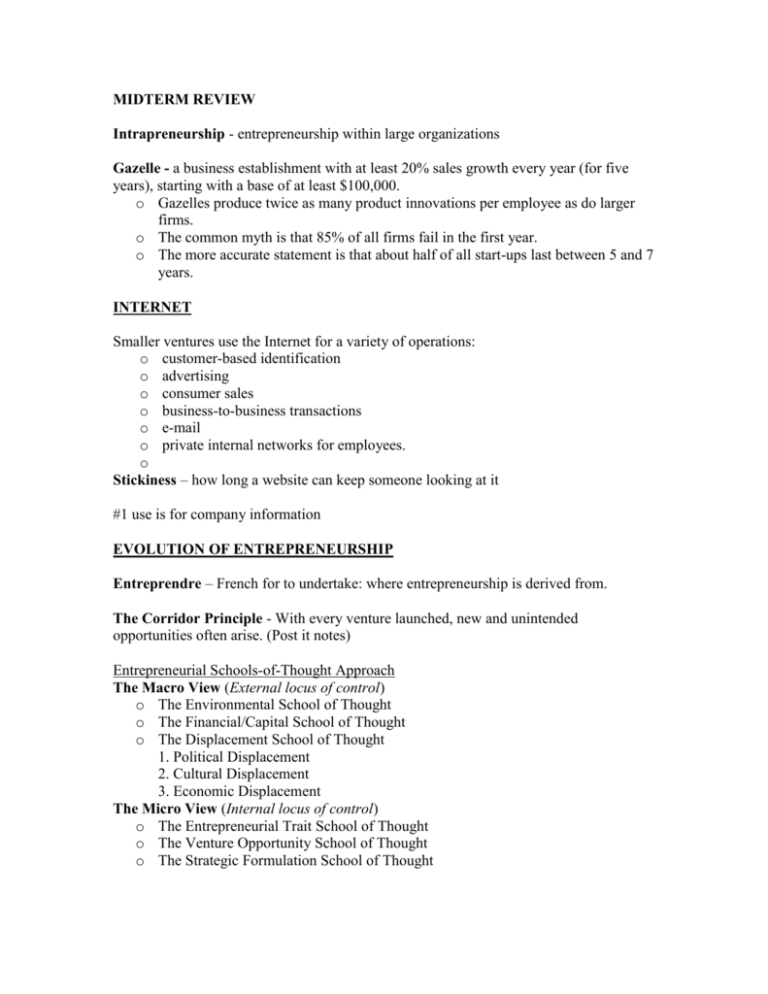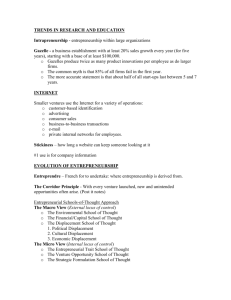Intrapreneurship - entrepreneurship within large organizations
advertisement

MIDTERM REVIEW Intrapreneurship - entrepreneurship within large organizations Gazelle - a business establishment with at least 20% sales growth every year (for five years), starting with a base of at least $100,000. o Gazelles produce twice as many product innovations per employee as do larger firms. o The common myth is that 85% of all firms fail in the first year. o The more accurate statement is that about half of all start-ups last between 5 and 7 years. INTERNET Smaller ventures use the Internet for a variety of operations: o customer-based identification o advertising o consumer sales o business-to-business transactions o e-mail o private internal networks for employees. o Stickiness – how long a website can keep someone looking at it #1 use is for company information EVOLUTION OF ENTREPRENEURSHIP Entreprendre – French for to undertake: where entrepreneurship is derived from. The Corridor Principle - With every venture launched, new and unintended opportunities often arise. (Post it notes) Entrepreneurial Schools-of-Thought Approach The Macro View (External locus of control) o The Environmental School of Thought o The Financial/Capital School of Thought o The Displacement School of Thought 1. Political Displacement 2. Cultural Displacement 3. Economic Displacement The Micro View (Internal locus of control) o The Entrepreneurial Trait School of Thought o The Venture Opportunity School of Thought o The Strategic Formulation School of Thought Strategic Formulation as a Leveraging of Unique Elements - Unique Markets: mountain gap strategies - Unique People: great chef strategies - Unique Products: better widget strategies - Unique Resources: water well strategies Process Approaches - “Integrative” Approach - Entrepreneurial Assessment Approach - Multidimensional Approach 3M’s Innovation Rules o Don’t kill a project o Tolerate failure o Keep divisions small o Motivate the champions o Stay close to the customer o Share the wealth Corporate Entrepreneurship Assessment Instrument (CEAI) (measured key entrepreneurial climate factors) o Management Support o Autonomy/Work Discretion o Rewards/Reinforcement o Time Availability o Organizational Boundary Venture Team - composed of two or more people who formally create and share the ownership of a new organization. o The leader is called a “product champion” or an “intrapreneur”. The Top Ten Characteristics Today’s Entrepreneurs Share: o Recognize and take advantage of opportunities o Resourceful o Creative o Visionary o Independent thinker o Hard worker o Optimistic o Innovator o Risk taker o Leader The Dark Side of Entrepreneurship o Confrontation with Risk 1. Financial Risk 2. Career Risk 3. Family and Social Risk 4. Psychic Risk o Stress o Ego 1. Extreme Sense of Distrust 2. Overbearing Need for Control 3. Overriding Desire for Success 4. Unrealistic Optimism Creativity - the generation of ideas that result in the improved efficiency or effectiveness of a system. Innovation - The process by which entrepreneurs convert opportunities into marketable ideas. More than just a good idea. 1. Types of Innovation o Invention o Extension o Duplication o Synthesis 2. Sources of Innovation 1. Unexpected Occurrences 2. Incongruities 3. Process Needs 4. Industry and Market Changes 5. Demographic Changes 6. Perceptual Changes 7. Knowledge-Based Concepts The four rationalizations are believing…. 1. that the activity is not “really” illegal or immoral; 2. that it is in the individual’s or the corporation’s best interest; 3. that it will never be found out; and 4. that because it helps the company, the company will condone it. Types of morally questionable acts: Non-role: Against the firm. Expense Acct cheating Role Failure: Against the firm. Superficial Performance Appraisal Role Distortion: For the firm. Bribery Role Assertion: For the firm. Not withdrawing product line until sold enough Code of conduct - is a statement of ethical practices or guidelines to which an enterprise adheres. Immoral Management: Managerial decisions, actions and behavior imply a positive and active oppositions to what is moral (ethical). Decisions are discordant with accepted ethical principles. An active negation of what is moral is implied. Amoral Management: Management is neither moral or immoral, but decisions lie outside the sphere to which moral judgments apply. Managerial activity is outside or beyond the moral order of a particular code. A lack of ethical perception and moral awareness may be implied. Moral Management: Managerial activity conforms to a standard of ethical, or right, behavior. Managers conform to accepted professional standards of conduct. Ethical Leadership is common- place on the part of management. A Holistic Approach Principle 1: Hire the right people Principle 2: Set standards more than rules Principle 3: Don’t let yourself get isolated Principle 4: The most important principle is to let your ethical example at all times be absolutely impeccable The Social Responsibility Challenge - Social Obligation: Some firms simply react to social issues through obedience to the laws – Social Responsibility: others respond more actively; accepting responsibility for various programs - Social Responsiveness: still others are highly proactive and are even willing to be evaluated by the public for various activities Pitfalls in Selecting New Ventures o Lack of Objective Evaluation o No Real Insight into the Market o Inadequate Understanding of Technical Requirements o Poor Financial Understanding o Lack of Venture Uniqueness o Ignorance of Legal Issues Critical Factors for New-Venture Development o Uniqueness o Investment o Sales Growth o Lifestyle ventures o Small profitable ventures o High-growth ventures o Product Availability o Customer Availability Why New Ventures Fail o Product/Market Problems o Financial Difficulties o Managerial Problems Types and Classes of First-Year Problems 1. Obtaining external financing 2. Internal financial management 3. Sales/marketing 4. Product development 5. Production/operations management 6. General management 7. Human resource management 8. Economic environment 9. Regulatory environment Business incubator - is a facility with adaptable space that small businesses can lease on flexible terms and at reduced rents. Types of Incubators 1. Publicly Sponsored 2. Nonprofit-sponsored 3. University-related 4. Privately sponsored Market - a group of consumers (potential customers) who have purchasing power and unsatisfied needs. A new venture will survive only if a market exists for its product or service. Marketing Philosophy? Production-driven philosophy Sales-driven philosophy Consumer-driven philosophy Market segmentation - is the process of identifying a specific set of characteristics that differentiate one group of consumers from the rest (market niche). Consumer Behavior Five Major Classifications: 1. Convenience goods: gum at the register, milk. 2. Shopping goods: things you shop for, car, house, college 3. Specialty goods: hard to find, price doesn’t matter, souveniers 4. Unsought goods: insurance, cemetery plot, they find you 5. New products: Unknown, new invention Pricing for the Product Life Cycle - Unique product: Skimming-deliberately setting a high price to maximize short-term profits - Non-unique product: Penetration-setting prices at such a low level that products are sold at a loss - Growth Stage: Consumer Pricing- combining penetration and competitive pricing to gain market share; depends on consumer’s perceived value of product - Maturity Stage: Demand oriented pricing- a flexible strategy that bases pricing decisions on the demand level for the product - Decline Stage: Loss Leader Pricing- pricing the product below cost in an attempt to attract customers to other products Geographic Pricing: depending on where you live The Balance Sheet - Represents the financial condition of a company at a certain date. It details the items the company owns (assets) and the amount the company owes (liabilities). It also shows the net worth of the company and its liquidity. The Income Statement - Commonly referred to as the P & L (profit and loss) statement, which provides the owner/manager with the results of operations. Statement of Cash Flow - An analysis of the cash availability and cash needs of the business. The Operating Budget - Typically, the first step in creating an operating budget is the preparation of the sales forecast. An entrepreneur can prepare the sales forecast in several ways. One way is to implement a statistical forecasting technique such as simple linear regression. The Cash-Flow Budget - The first step in the preparation of the cash-flow budget is the identification and timing of the cash inflows. For the typical business, cash inflows will come from three sources: (1) cash sales, (2) cash payments received on account, and (3) load proceeds. Pro Forma Statements - Pro forma statements are projections of a firm’s financial position over a future period (pro forma income statement) or on a future date (pro forma balance sheet). Capital Budgeting - The first step in capital budgeting is to identify the cash flows and their timing. The inflows, or returns as they are commonly called, are equal to net operating income before deduction of payments to the financing sources but after the deduction of applicable taxes and with depreciation added back. Payback Method - In this method the length of time required to “pay back” the original investment is the determining criterion. Net Present Value (NPV method) - The concept works on the premise that a dollar today is worth more than a dollar in the future. The cost of capital is the rate used to adjust future cash flows to determine their value in present period terms. This procedure is referred to as discounting the future cash flows, and the discounted cash value is determined by the present value of the cash flow. Internal Rate of Return (IRR method) - This method is similar to the net present value method in that the future cash flows are discounted. However, they are discounted at a rate that makes the net present value of the project equal to zero. Pitfalls to Avoid in Planning Pitfall 1: No Realistic Goals Pitfall 2: Failure to Anticipate Roadblocks Pitfall 3: No Commitment or Dedication Pitfall 4: Lack of Demonstrated Experience (Business or Technical) Pitfall 5: No Market Niche (Segment) Business Plan: no more than 40 pages and summary no more that 2 pages.








